Space Scouts. American spy satellites
16 March 1955, the US Air Force officially ordered the development of an advanced reconnaissance satellite to provide continuous monitoring of the 'pre-selected areas of the Earth' to determine the readiness for war of a potential enemy.
28 February The first photo-reconnaissance satellite created using the CORONA program (the open name Discoverer) was launched in the USA. He was supposed to conduct reconnaissance above all over the USSR and China. Photos taken by his equipment, developed by Itek, were returned to Earth in a descent capsule. The reconnaissance equipment was first sent into space in the summer of 1959 of the year by the fourth unit of the series, and the first successful return of the capsule with the captured film was made from the Discoverer 1959 satellite in August of 14.
CORONA is an American space defense program. It was developed by the CIA Science Office with the support of the US Air Force. Intended for tracking land targets of a potential enemy, mainly the USSR and the PRC. Effective from June 1959 to May 1972.
The program launched the following satellite models: KH-1, KH-2, KH-3, KH-4, KH-4A and KH-4B (from the English KeyHole - keyhole). The satellites were equipped with long-focal wide-format photo cameras and other surveillance devices. In total, the 144 satellite was launched as part of the CORONA program, 102 of which took useful pictures.
For the sake of misinformation, the first Key Hole satellites were reported as part of the peaceful space program Discoverer (literally “Explorer”, “discoverer”). Since February 1962, the program “Corona” has become particularly secret and has ceased to hide under the name Discoverer. Discoverer-2 without photographic equipment fell on Svalbard and, as suggested in the United States, was most likely chosen by a Soviet search party.
For the first time, the name “Key Hole” is found in 1962 for KH-4, later it was retrospectively called the entire series of satellites launched by this year. KN-1 series satellites are the first military satellites and specific intelligence in particular. Pictures from the KH-5 Argon first captured Antarctica from space.
In total, the 144 satellite was launched, the 102 descent capsules returned with acceptable photos. The last satellite launch of the Corona program was carried out on 25 on May 1972. The project was stopped due to the discovery of a Soviet submarine waiting in the area of splashing down capsules with film in the Pacific Ocean. The most successful filming period was 1966 — 1971 of the year, when 32 had a successful launch with the return of a suitable film.
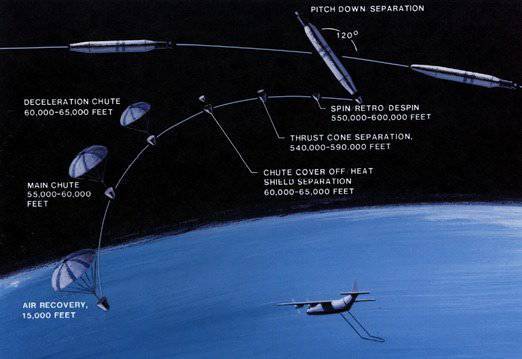
Of all the launches of the KH-1 series, only one was completely successful. Discovery satellite capsule -14 with photo materials of satisfactory quality was picked up by an airplane and delivered to its destination.
The launch of Discoverer-4 28 February 1959 of the year was unsuccessful. Due to insufficient acceleration of the 2-th stage, the satellite could not reach the orbit.
Discoverer-5 was successfully launched on 13 August 1959. On August 14, a descent capsule was separated from the vehicle. With the help of the brake engine, it was lowered over the Pacific Ocean. However, no beacon signals were received from the capsule, and it was not possible to find it.
Discoverer-6 was successfully launched by Tor-Agen rocket from Vandenberg base 19 August 1959. The failure of the descent capsule brake engine caused its loss.
Discoverer-7 was successfully launched by the Tor-Ajen rocket from the Vandenberg base 7 on November 1959. The power supply failed to ensure the normal operation of the control and stabilization system, and the device began to tumble in orbit. The separation of the descent capsule failed.
Discoverer-8 was successfully launched by the Tor-Ajen rocket from the Vandenberg base 20 on November 1959. After the 15 coils around the Earth, the descent capsule was separated. However, during the descent, the parachute did not open, the capsule landed outside the planned descent zone, and it was not possible to find it.
The launch of Discoverer-10 failed. Failure of the launch vehicle control system.
Discovery-11 was designed to assess how quickly the USSR produces long-range bombers and ballistic missiles, as well as their deployment sites. The launch of Discoverer-11 was successful. However, it was not possible to return the capsule with the captured film to Earth due to the failure of the height control system.
The first CORONA KH-2 satellite, Discoverer-16 (CORONA 9011), was launched on October 26 1960 in 20: 26 UTC. The launch ended with a launch vehicle crash. Next satellite series «KH-2 CORONA» steel "Discoverer-18», "Discoverer-25» and "Discoverer-26» successfully fulfilled their mission in 1960-1961 year, as well as the "Discoverer-17», "Discoverer-22» and Discoverer-28, whose missions were also unsuccessful.
Characteristics of satellites KN-2:
The mass of the devices is about 750 kg,
Film - 70-mm,
The length of the film in the cassette - 9600 meters
The lens focal length is about 60 cm.
CORONA spy satellites (KH-1, KH-2, KH-3, KH-4) radically improved the US understanding of the activities and potential of the USSR and other states. Perhaps, the first success came already after 18 months after the first successful launch of the satellite under the CORONA program. The collected photographic material allowed the Americans to dispel the fear of falling behind in the rocket race. If previously there were estimates of the appearance of hundreds of Soviet ICBMs by 1962, by September 1961, the number of missiles was estimated only from 25 to 50 units. By June, 1964 CORONA satellites photographed all 25 Soviet intercontinental ballistic missile complexes. The images received from CORONA satellites also allowed the Americans to catalog the Soviet positions of air defense and missile defense, atomic facilities, submarine bases, tactical ballistic missiles, and an air base. The same applies to military facilities in China, Eastern Europe and other countries. Space imagery also helped to monitor the preparation and course of military conflicts, such as the 1967 seven-day war of the year, and to monitor the USSR’s compliance with arms limitation and reduction treaties.
KH-5 is the Key Hole satellites series intended for low resolution imagery in addition to other reconnaissance satellites to create mapping products
KH-6 Lanyard (English Lanyard - cord, strap) - a series of short-lived species intelligence satellites, created in the US from March to July 1963 of the year. The first launches were planned to be used for shooting the surface area near Tallinn. In 1963, American intelligence assumed that Soviet anti-missiles could be deployed there.
KA mass - 1500 kg. The satellite was equipped with a camera with a lens with a focal length of 1,67 meters and a terrain resolution of 1,8 meters. In total, there were three launches, one of them was unsuccessful, the other was without film and only one was successful. Shooting was made on 127-millimeter (5-inch) film. The capsule contained 6850 film meters, 910 frames were captured.
KH-7 is a series of Key Hole satellites, with a very high (for its time) resolution. Intended for shooting of especially important objects in the territory of the USSR and China. Satellites of this type were launched from July 1963 of the year to June of the 1967 year. All KH-38 7 satellites were launched from Vandenberg airbase, 30 from the bottom returned with photos of satisfactory quality.
Initially, the terrain resolution was 1,2 meters, but was improved to 0,6 meters in 1966.
KH-8 (also - Gambit-3) is a series of American reconnaissance satellites for detailed optical photographic reconnaissance. Another name used was the Low Altitude Surveillance Platform. The series has become one of the longest-lived US space programs. From July 1966 to April 1984, 54 launches took place. For photographing the Earth's surface, photographic film was used, the filmed material was returned to the ground in special containers. After entering the dense layers of the atmosphere, the parachute had to open to ensure a soft landing. According to official reports, the actually achieved resolution of the apparatus was no worse than half a meter. The device weighing 3 tons was produced by the Lockheed campaign and was launched into space by the Titan 3 launch vehicle from the Vandenberg cosmodrome. The equipment for the survey was produced by the A&O division of the Eastman Kodak campaign. The name "Gambit" was also used to refer to the predecessor of the KH-8, the KH-7.
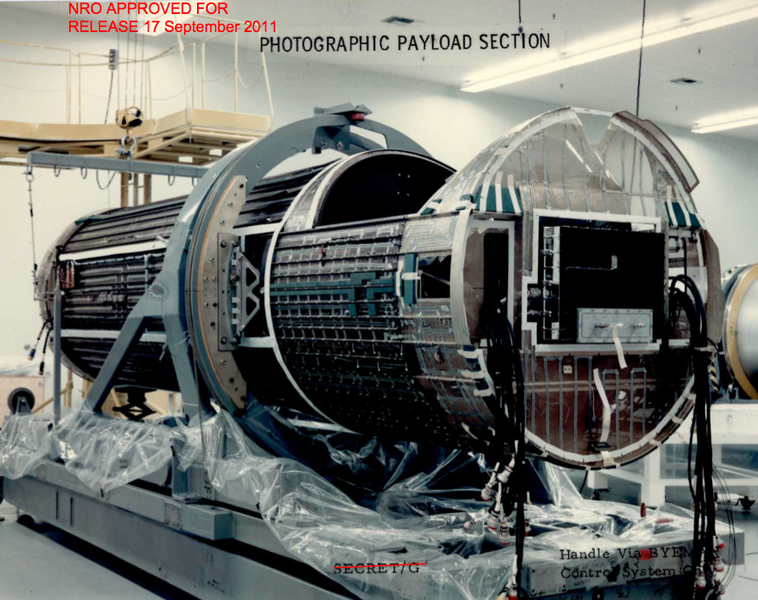
The film used in the Gambit satellites was produced by the Eastman-Kodak campaign. Subsequently, the "space" film has evolved into a whole family of successfully used photographic materials with high characteristics. The first was a “Type 3404” film with 50 resolution on 100 lines per square millimeter. This was followed by several high-resolution modifications “Type 1414” and “SO-217”. A series of films made using fine grains of silver halides has also appeared. Consistently reducing the size of the latter from 1,550 arngstrom in "SO-315" to 1200 arngstrom in "SO-312" and to 900 angstroms in the model "SO-409", the manufacturer managed to achieve high performance on film resolution and uniformity. The latter is important for the invariability of the quality of the resulting image.
Under ideal conditions, according to official data, Gambit intelligence officers were able to distinguish objects from 28 to 56 on the earth's surface (using the “3404 Type” film) and even 5-10 cm (using the more advanced “3409 Type” film) with 320 resolution on 630 lines per sq. mm). In reality, ideal conditions are very rare. The quality of shooting from space is influenced by a large number of factors. Serious deterioration in the atmosphere can also be caused by, for example, surface heating (a boiling effect) and industrial smog and dust in the near-surface layer, raised by the wind, and the angle of incidence of sunlight and, of course, too high an orbit height. Perhaps, therefore, the actual resolution of the images received by the KH-8 series satellites, until now (2012 year) remains classified.
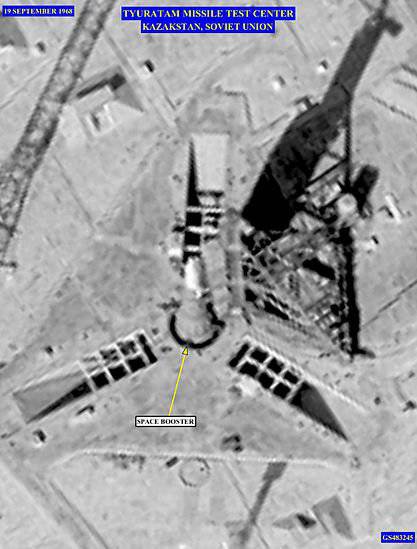
The KH-8 series had the opportunity to photograph satellites in orbit. This feature was developed to monitor the activities of Soviet satellites, but was first used to shoot a damaged Skylab station in 1973.
The KH-9 program was conceived at the start of the 1960's as a replacement for the CORONA tracking satellites. Intended for tracking large areas of the earth's surface with a medium resolution camera. The KH-9 devices were equipped with two main cameras, and some missions were also equipped with a map camera. The film from the cameras was reloaded into the capsules of the returned vehicles and sent to Earth, where they were intercepted by an airplane in the air. On most missions, there were four return vehicles. The fifth capsule was on missions that had a map camera.
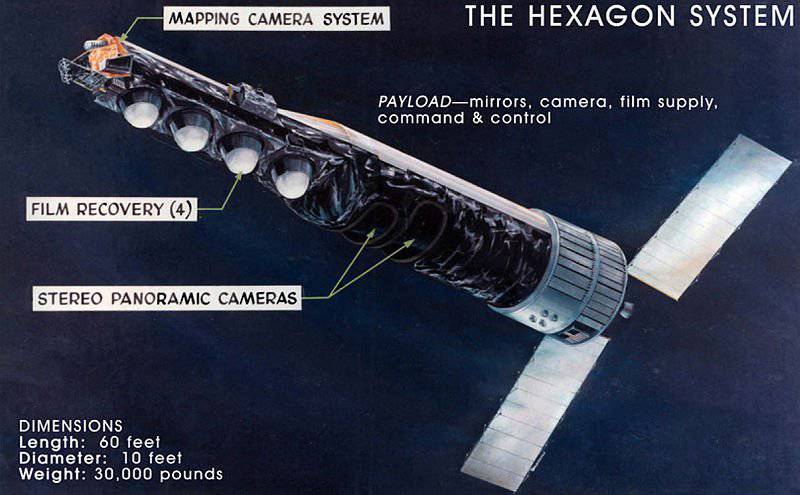
Of the twenty launches made by the US Air Force, all but one were successful. Filmed photographic film for processing and analysis from the satellite was sent back to Earth in returning parachute capsules to the Pacific Ocean, where military planes C-130 picked them up with special hooks. The best resolution achieved by the main cameras was 0,6 meters.
In September, 2011, the materials on the Hexagon spy satellite project were declassified, and for one day one of the spacecraft (SC) was exposed to everyone.
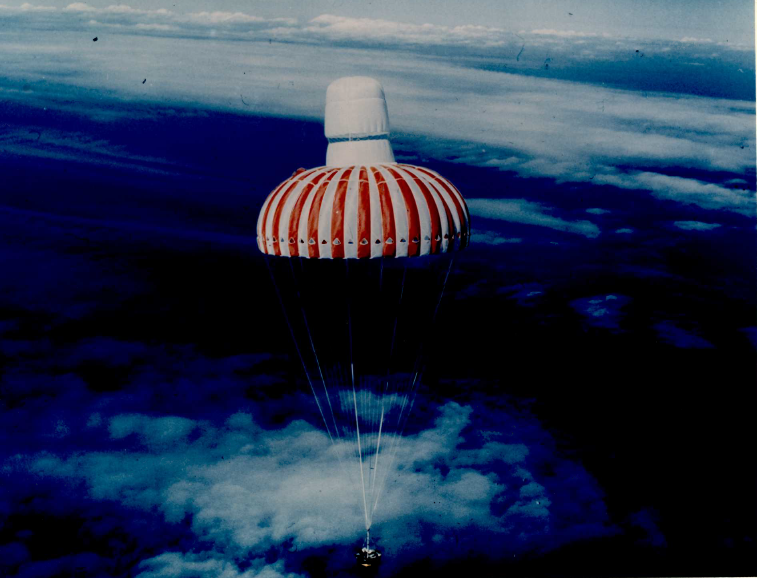
KN-10 Dorian - Manned Orbiting Laboratory (MOL) - orbital station, part of the program of manned missions of the US Department of Defense. Astronauts at the station had to engage in intelligence activities and be able to remove from orbit or destroy satellites if necessary. Work on it was discontinued in 1969, as the new strategy of the Ministry of Defense provided for the use of unmanned vehicles for intelligence purposes.
In the 1970-ies in the USSR, launches were carried out similar stations on purpose "Almaz".
It was planned that the MOL station would be delivered to orbit by the Titan IIIC carrier rocket along with the Gemini B spacecraft, which was to have a crew of two military astronauts on board. Astronauts would spend observations and experiments for 30 days, then leave the station. MOL was designed to work only one crew.
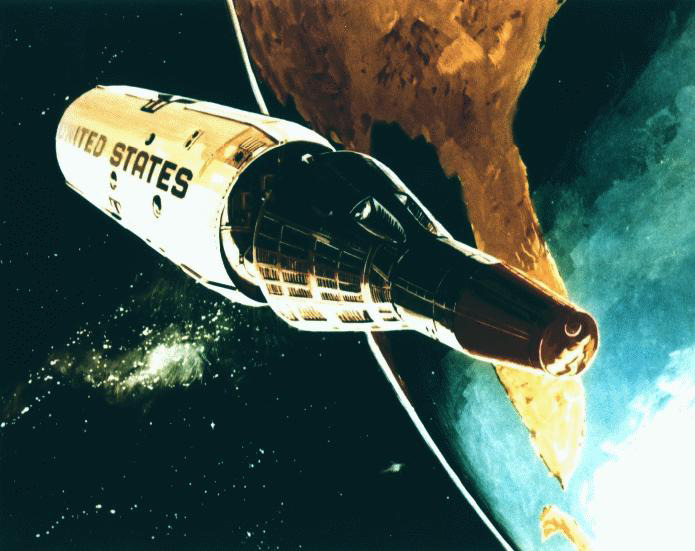
According to the manned orbital laboratory program, one test launch of 3 November 1966 of the year was made. For the tests, the MOL model and the Gemini-2 spacecraft were used, which was reused after its first 18-minute suborbital flight in the 1965 year. The launch was carried out using the Titan IIIC launch vehicle from the launch pad LC-40 of the US Air Force base at Cape Canaveral.
The first manned flight after numerous delays was scheduled for December 1970, however, President Nixon canceled the MOL program due to delaying work, exceeding the budget for them, and also because the program was outdated because reconnaissance satellites could perform most of the tasks assigned to it .
KH-11 KENNAN, also known under the code names 1010 and Crystal (usually called Key Hole), is a type of reconnaissance satellites that were launched by the National Directorate of Military Space Intelligence of the USA from 1976 to 1990 year. Manufactured by the Lockheed Corporation in Sunnyvale, California, the KH-11 became the first American spy satellite to use an optical-electronic digital camera and transmit the resulting images almost immediately after taking pictures.
Nine KH-11 satellites were launched between 1976 and 1990 for years on board the Titan IIID and −34D launch vehicles, with one emergency launch. The KH-11 device replaced the KH-9 Hexagon photographic satellites, the last of which was lost during the launch of the launch vehicle in 1986. It is assumed that KH-11 resemble in size and shape the Hubble Space Telescope, as they were sent into space in identical containers. Also, NASA, describing history The Hubble telescope, in describing the reasons for the transition from the 3-meter main mirror to the 2,4-meter, states: "In addition, the transition to the 2,4-meter mirror allowed us to reduce manufacturing costs using production technologies developed for military spy satellites."
Provided that an 11-meter mirror is placed on the KH-2,4, its theoretical resolution in the absence of atmospheric distortion and the 50% frequency-contrast characteristic will be approximately 15 cm. The working resolution will be worse due to the influence of the atmosphere. Versions of KH-11 vary in weight from 13,000 to 13,500 kg. The estimated length of the satellites is 19,5 meters, diameter is 3 meters. The data was transmitted through a satellite data transmission system (Satellite Data System) owned by the US military.
In 1978, a young CIA officer, William Campiles, sold the USSR for $ 3,000 technical guidance describing the design and operation of KH-11. Campiles was convicted of spying on 40 years in prison (he was released after 18 years in prison).
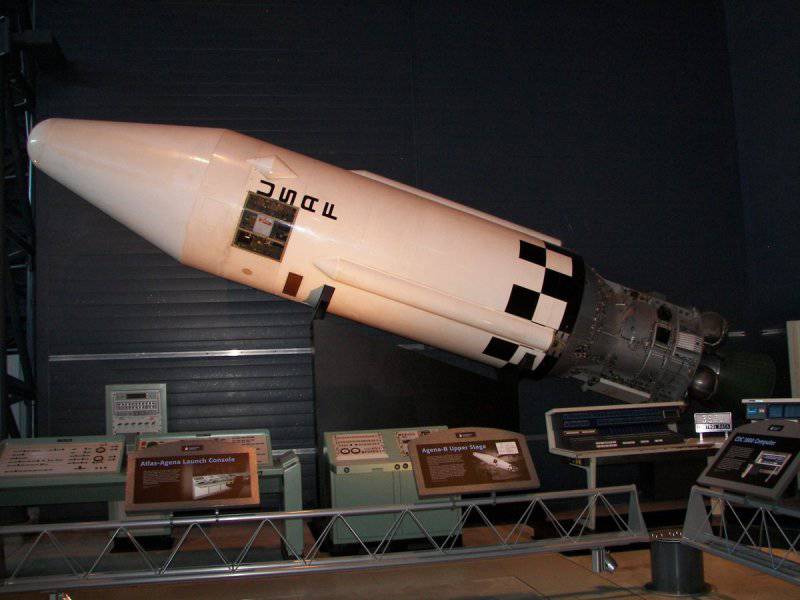
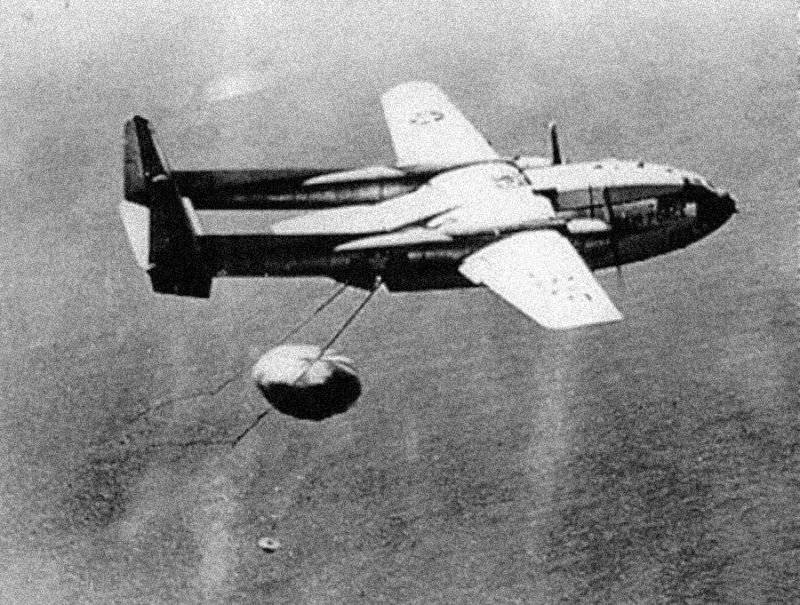
Information